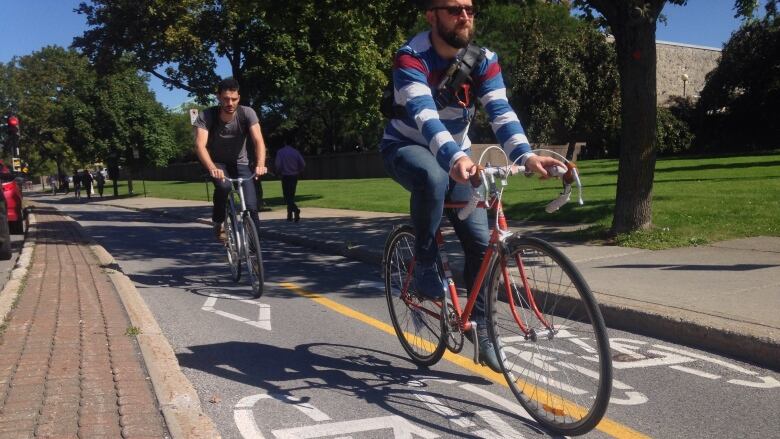Cycling safety recommendations: What the city wants
Montreal issued 20 recommendations today, ranging from allowing cyclists to use sidewalks in some circumstances to increasing fines for "dooring," aimed at ensuring Quebecers are sharing the road more equably.
Recommendations include measures to reduce dangers of 'dooring'

Montreal issued 20 recommendations today, ranging from allowing cyclists to use sidewalks in some circumstances to increasing fines for "dooring," aimed at ensuring Quebecers are sharing the road more equably.
Take a look at what the city is, and is not, recommending.
What the city is recommending:
- Introducing an overall precautionary principle for drivers to watch out for more vulnerable forms of transport, including cyclists.
- Permitting the "Idaho stop," which would allowcyclists to treat stop signs like yield signs. (The city considered recommending cyclists be allowed to do the same at red lights, but decided against it).
- No longer requiring cyclists to stay to the far right (to reduce cases of "dooring," when a driver opens the door of a parked car and a cyclist strikes it).
- Requiringpassing cars to stay at least onemetre from cyclists.
- Including "dooring" in the definition of an accident.
- Increasing fines for "dooring".
- Increasing fines for cyclist who break the law, but not though ademerit pointsystem.
- Including bicyclesin vehicle definition for impaired driving regulations.
- Includingcyclists in Highway Safety Code prohibitionson cell phones, screens, andheadphone use.
- Defining what is and what is not a "bicycle" ( the city recommends excluding electric scooters from that definition).
- Defining what is allowed on a bike path (Montreal already allowsrollerblades, electric-assisted bicycles, and scooters for people with physical mobility limitations, but not other electric scooters).
- Allowing cyclists on the sidewalks in specific cases, for safety reasons.
- Allowing cyclists to go when the pedestrian light turns green (where safe).
- Allowing for different braking systems on bikes (front or back wheel)
- More flexibility inreflector requirements.
- Allowing cyclists to ride between two rows of cars in situations where the right hand lane is a right-turn only, or a bus lane where they are not allowed.
- Allowing cyclists to ride in bus lanes wheresignage permits it.
- Allowing cyclists to ride side-by-side, where it's safe.
- Strengthening the priority for cyclists going straight through an intersection over a person turning right at a four-way stop.
- Mandating lateral truck guards and other protections for trucks to better detect cyclists.
What thecity does not recommend:
- Mandatory helmets.
- Idaho stops at red lights.
- Removing the requirement for cyclists to make hand signals before turning.
- Designating paths in municipal parks to fall under theHighway Safety Code (the city wants to retain discretion to regulate this).
- Making snow tires mandatory for bikes.












_(720p).jpg)


 OFFICIAL HD MUSIC VIDEO.jpg)
.jpg)



























































































